Fabrication of Super-Hydrophobic Microchannels via Strain-Recovery Deformations of Polystyrene and Oxygen Reactive Ion Etch
Abstract
:1. Introduction
2. Fabrication Procedure
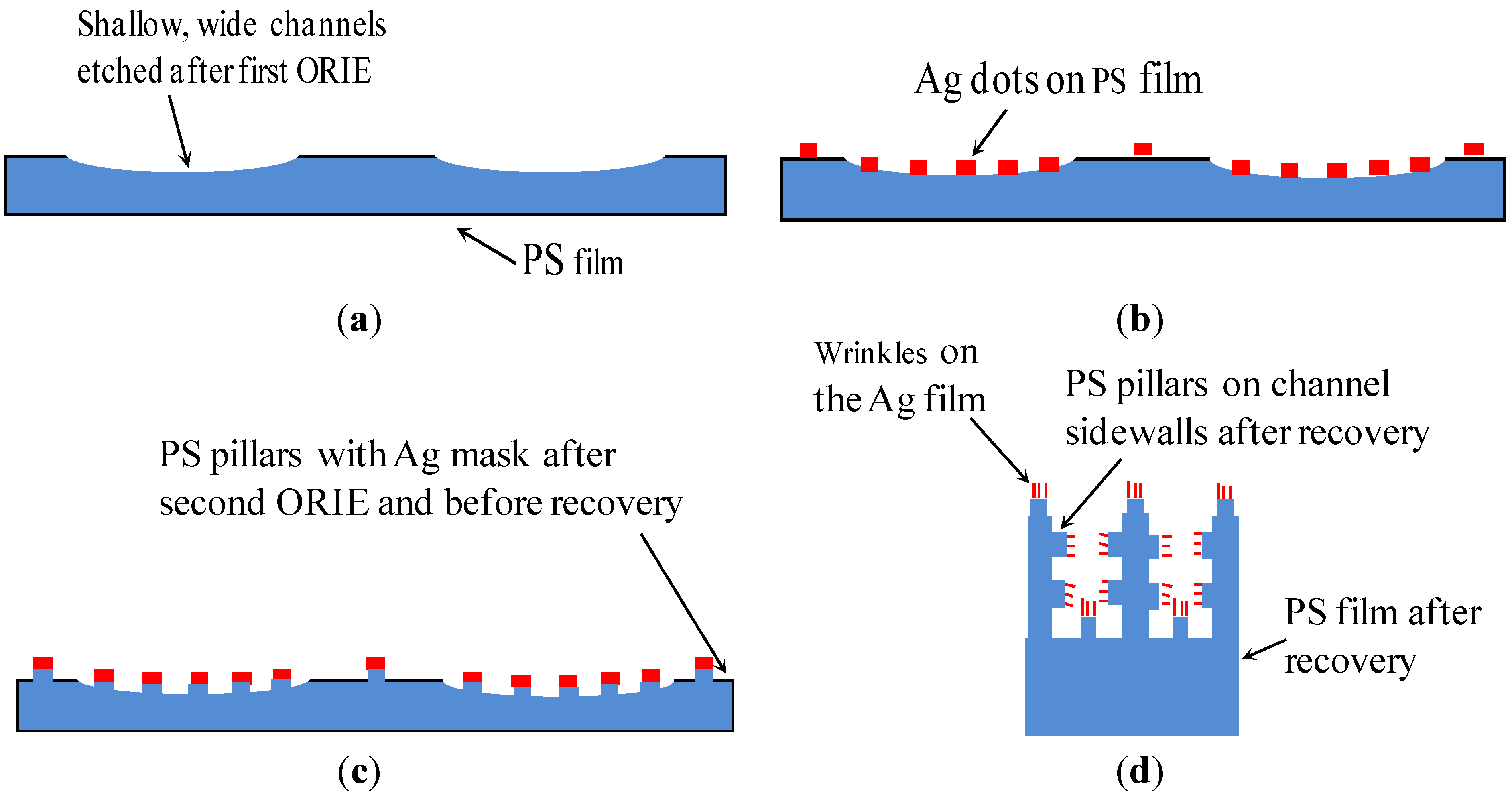
3. Experimental and Discussions
3.1. Preliminary Tests
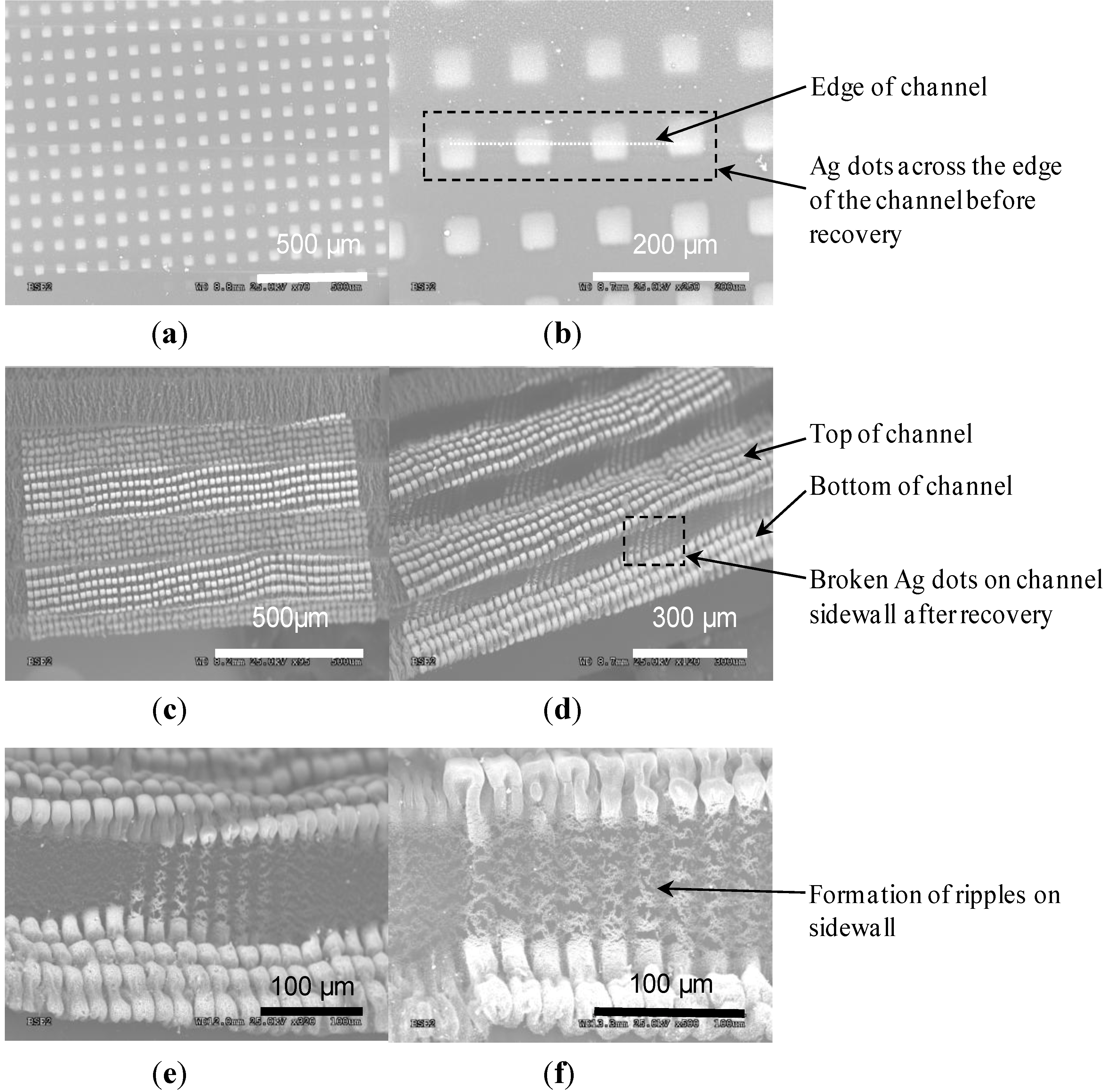
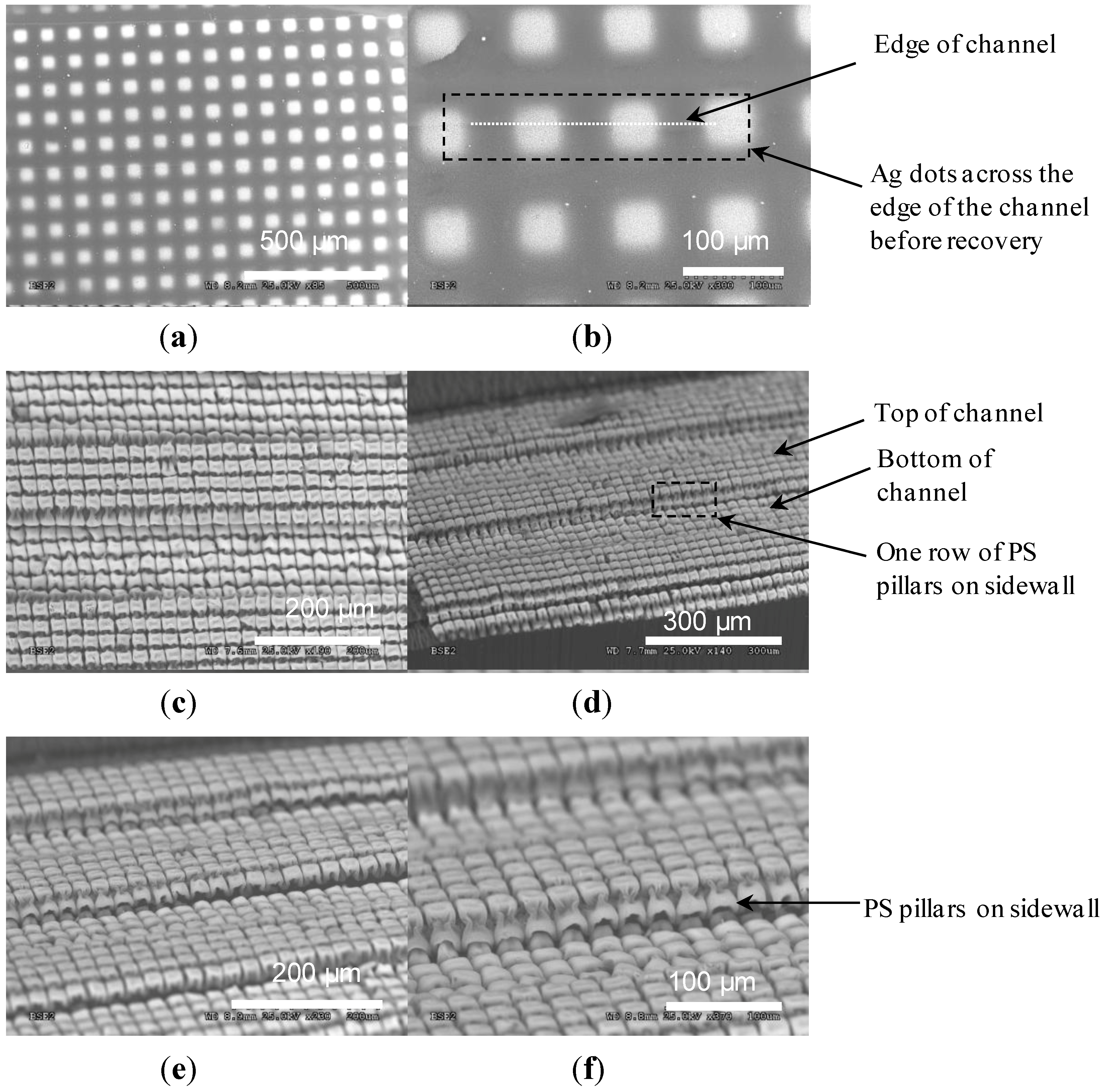
3.2. Generated Microchannels

3.3. Recovered Micropillars
3.4. Wetting Tests
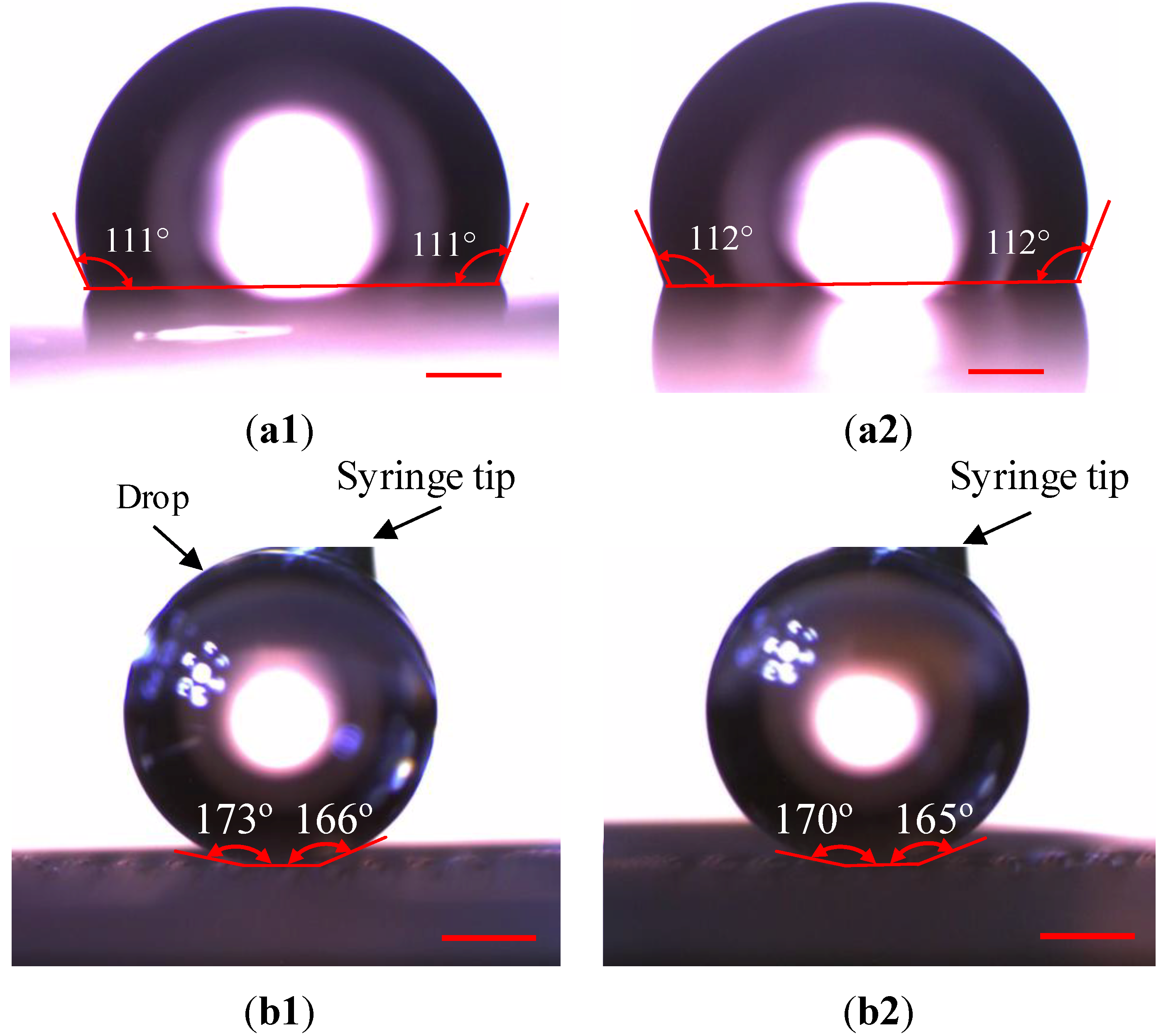
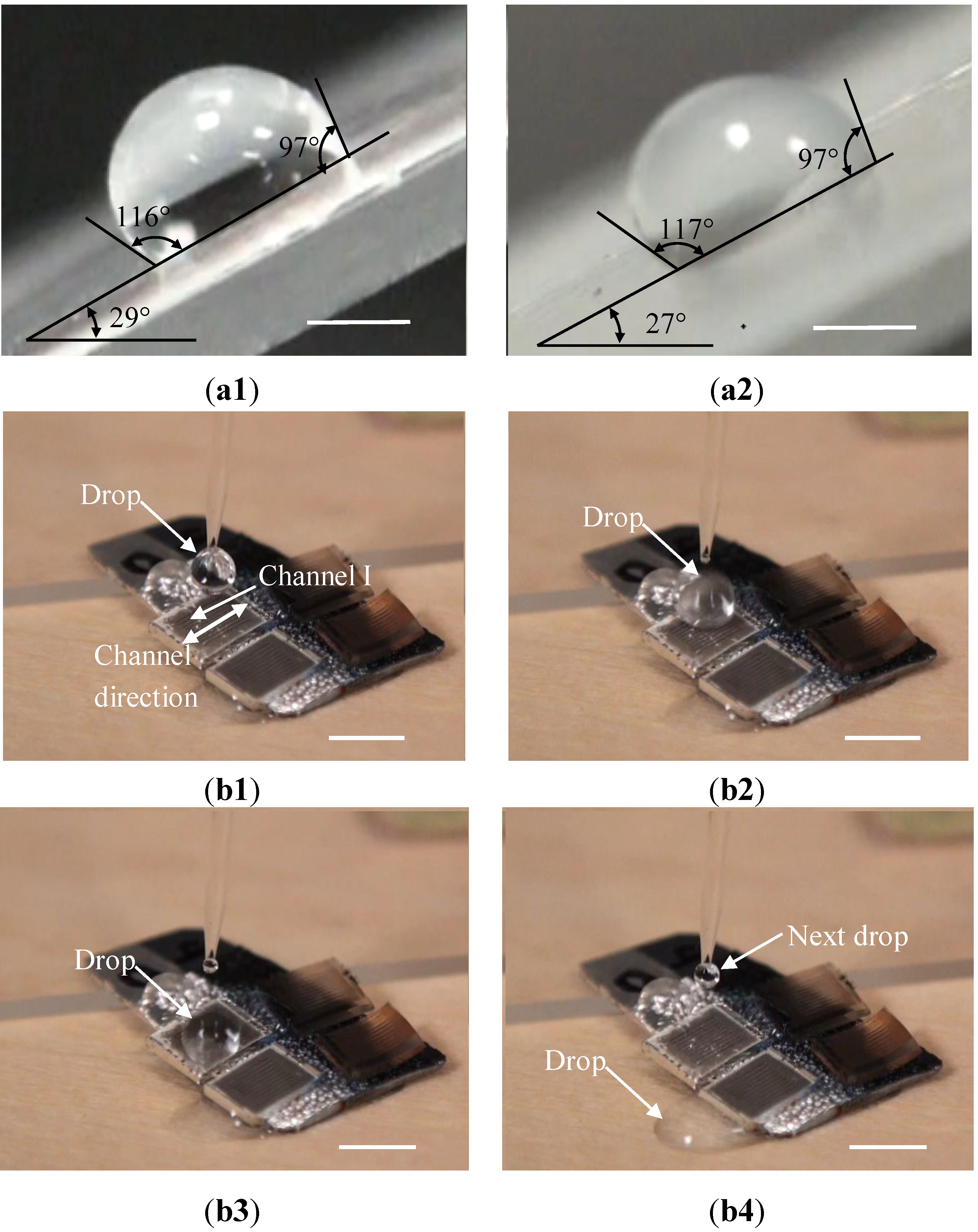
4. Conclusions
Conflicts of Interest
References
- Neinhuis, C.; Barthlott, W. Characterization and distribution of water-repellent, self-cleaning plant surfaces. Ann. Bot Lond. 1997, 79, 667–677. [Google Scholar] [CrossRef]
- Xiang, M.M.; Wilhelm, A.; Luo, C. Existence and role of large micropillars on the leaf surfaces of the president lotus. Langmuir 2013, 29, 7715–7725. [Google Scholar] [CrossRef] [PubMed]
- Wenzel, R.N. Resistance of solid surfaces to wetting by water. Ind. Eng. Chem. 1936, 28, 988–994. [Google Scholar] [CrossRef]
- Cassie, A.B.D.; Baxter, S. Wettability of porous surfaces. Trans. Faraday Soc. 1944, 40, 546–550. [Google Scholar] [CrossRef]
- Lauga, E.; Stone, H.A. Effective slip in pressure-driven Stokes flow. J. Fluid Mech. 2003, 489, 55–77. [Google Scholar] [CrossRef]
- Ou, J.; Perot, B.; Rothstein, J.P. Laminar drag reduction in microchannels using ultrahydrophobic surfaces. Phys. Fluids 2004, 16, 4635–4643. [Google Scholar] [CrossRef]
- Ybert, C.; Barentin, C.; Cottin-Bizonne, C.; Joseph, P.; Bocquet, L. Achieving large slip with superhydrophobic surfaces: Scaling laws for generic geometries. Phys. Fluids 2007, 19, 123601:1–123601:10. [Google Scholar] [CrossRef]
- Zhu, L.B.; Xiu, Y.H.; Xu, J.W.; Tamirisa, P.A.; Hess, D.W.; Wong, C.P. Superhydrophobicity on two-tier rough surfaces fabricated by controlled growth of aligned carbon nanotube arrays coated with fluorocarbon. Langmuir 2005, 21, 11208–11212. [Google Scholar] [CrossRef] [PubMed]
- Koch, K.; Bhushan, B.; Jung, Y.C.; Barthlott, W. Fabrication of artificial lotus leaves and significance of hierarchical structure for superhydrophobicity and low adhesion. Soft Matter 2009, 5, 1386–1393. [Google Scholar] [CrossRef]
- Ming, W.; Wu, D.; van Benthem, R.; de With, G. Superhydrophobic films from raspberry-like particles. Nano Lett. 2005, 5, 2298–2301. [Google Scholar] [CrossRef] [PubMed]
- Chong, M.A.S.; Zheng, Y.B.; Gao, H.; Tan, L.K. Combinational template-assisted fabrication of hierarchically ordered nanowire arrays on substrates for device applications. Appl. Phys. Lett. 2006, 89, 233104:1–233104:3. [Google Scholar]
- Zhang, Y.; Sundararajan, S. Superhydrophobic engineering surfaces with tunable air-trapping ability. J. Micromech. Microeng. 2008, 18. [Google Scholar] [CrossRef]
- Choi, S.J.; Suh, K.Y.; Lee, H.H. A geometry controllable approach for the fabrication of biomimetic hierarchical structure and its superhydrophobicity with near-zero sliding angle. Nanotechnology 2008, 19. [Google Scholar] [CrossRef]
- Jeong, H.E.; Kwak, M.K.; Park, C.I.; Suh, K.Y. Wettability of nanoengineered dual-roughness surfaces fabricated by UV-assisted capillary force lithography. J. Colloid Interface Sci. 2009, 339, 202–207. [Google Scholar] [CrossRef] [PubMed]
- Koch, M.; Evans, A.G.R.; Brunnschweiler, A. Design and fabrication of a micromachined Coulter counter. J. Micromech. Microeng. 1999, 9, 159–161. [Google Scholar] [CrossRef]
- Nellissen, T.; Wang, L.; Wehrens, R.; van den Heuvel, E.; Wererings, J. A Novel Photolithographic Method for Realizing 3-D Interconnection Patterns on Electronic Modules. In Proceedings of the 14th European Microelectronics and Packaging Conference, Friedrichshafen, Germany, 23–25 June 2003; p. 347.
- Pham, N.P.; Burghartz, J.N.; Sarro, P.M. Spray coating of photoresist for pattern transfer on high topography surfaces. J. Micromech. Microeng. 2005, 15, 691–697. [Google Scholar] [CrossRef]
- Su, W.; Lee, S.; Tsai, M.; Fang, W. 3D Lithography and Deposition on Highly Structured Surfaces Using Plasma Surface Modification, SAM Coating, and Contact Displacement Electroless Plating. In Proceedings of the 19th IEEE International Conference on Micro Electro Mechanical Systems, Istanbul, Turkey, 22–26 January 2006; pp. 274–277.
- Wang, H.; Chakraborty, A.; Luo, C. Fabrication of Au micropatterns on vertical Si sidewalls using flexible PDMS shadow masks. J. Micromech. Microeng. 2010, 20. [Google Scholar] [CrossRef]
- Wang, H.; Luo, C. Generation of Au micropatterns on two sidewalls of a Si channel through a PDMS shadow mask. J. Micromech. Microeng. 2011, 21. [Google Scholar] [CrossRef]
- Luo, C.; Xiang, M.M.; Heng, X. A stable intermediate wetting state after a water drop contacts the bottom of a microchannel or is placed on a single corner. Langmuir 2012, 28, 9554–9561. [Google Scholar] [CrossRef] [PubMed]
- Liu, X.C.; Luo, C. Fabrication of Au sidewall micropatterns using Si-reinforced PDMS molds. Sens. Actuator A Phys. 2009, 152, 96–103. [Google Scholar] [CrossRef]
- Liu, X.C.; Luo, C. Fabrication of super-hydrophobic channels. J. Micromech. Microeng. 2010, 20. [Google Scholar] [CrossRef]
- Chakraborty, A.; Liu, X.C.; Luo, C. Generation of sidewall patterns in microchannels via strain-recovery deformations of polystyrene. Sens. Actuator A Phys. 2012, 188, 374–382. [Google Scholar] [CrossRef]
- Wang, C.C.; Huang, W.M.; Ding, Z; Zhao, Y.; Purnawali, H. Cooling-/water-responsive shape memory hybrids. Compos. Sci. Technol. 2012, 72, 1178–1182. [Google Scholar] [CrossRef]
- Hidber, P.C.; Nealey, P.F.; Helbig, W.; Whitesides, G.M. New strategy for controlling the size and shape of metallic features formed by electroless deposition of copper: Microcontact printing of catalysts on oriented polymers, followed by thermal shrinkage. Langmuir 1996, 12, 5209–5215. [Google Scholar] [CrossRef]
- Zhao, X.; Xia, Y.; Schueller, O.; Qin, D.; Whitesides, G. Fabrication of microstructures using shrinkable PS films. Sens. Actuator A Phys. 1998, 65, 209–217. [Google Scholar] [CrossRef]
- Grimes, A.; Breslauer, D.N.; Long, M.; Pegan, J.; Lee, L.P.; Khine, M. Shrinky-Dink microfluidics: Rapid generation of deep and rounded patterns. Lab Chip 2008, 8, 170–172. [Google Scholar] [CrossRef] [PubMed]
- Liu, X.C.; Chakraborty, A.; Luo, C. Fabrication of micropatterns on the sidewalls of a thermal shape memory polystyrene block. J. Micromech. Microeng. 2010, 20. [Google Scholar] [CrossRef]
- Luo, C.; Liu, X.C.; Poddar, R.; Garra, J.; Gadre, A.P.; Keuren, E.V.; Schneider, T.; White, R.; Currie, J.; Paranjape, M. Thermal ablation of PMMA for water release using a microheater. J. Micromech. Microeng. 2006, 16. [Google Scholar] [CrossRef]
- Irie, M. Shape Memory Polymers. In Shape Memory Materials; Otsuka, K., Wayman, C.M., Eds.; Cambridge University Press: Cambridge, UK, 1998. [Google Scholar]
- Bowden, N.; Brittain, S.; Evans, A.G.; Hutchinson, J.W.; Whitesides, G.M. Spontaneous formation of ordered structures in thin films of metals supported on an elastomeric polymer. Nature 1998, 393, 146–149. [Google Scholar] [CrossRef]
- Zhao, Y.; Huang, W.M.; Fu, Y.Q. Formation of micro/nano-scale wrinkling patterns atop shape memory polymers. J. Micromech. Microeng. 2011, 21. [Google Scholar] [CrossRef]
- Cheng, M.C.; Garra, J.A.; Gadre, A.P.; Nijdam, A.J.; Luo, C.; Paranjape, M.; Currie, J.F.; Schneider, T.; White, R. Dry lease of polymer structures with anti-sticking layer. J. Vac. Sci. Technol. A 2004, 22, 837–841. [Google Scholar] [CrossRef]
© 2013 by the authors; licensee MDPI, Basel, Switzerland. This article is an open access article distributed under the terms and conditions of the Creative Commons Attribution license (http://creativecommons.org/licenses/by/3.0/).
Share and Cite
Chakraborty, A.; Xiang, M.; Luo, C. Fabrication of Super-Hydrophobic Microchannels via Strain-Recovery Deformations of Polystyrene and Oxygen Reactive Ion Etch. Materials 2013, 6, 3610-3623. https://doi.org/10.3390/ma6083610
Chakraborty A, Xiang M, Luo C. Fabrication of Super-Hydrophobic Microchannels via Strain-Recovery Deformations of Polystyrene and Oxygen Reactive Ion Etch. Materials. 2013; 6(8):3610-3623. https://doi.org/10.3390/ma6083610
Chicago/Turabian StyleChakraborty, Anirban, Mingming Xiang, and Cheng Luo. 2013. "Fabrication of Super-Hydrophobic Microchannels via Strain-Recovery Deformations of Polystyrene and Oxygen Reactive Ion Etch" Materials 6, no. 8: 3610-3623. https://doi.org/10.3390/ma6083610



